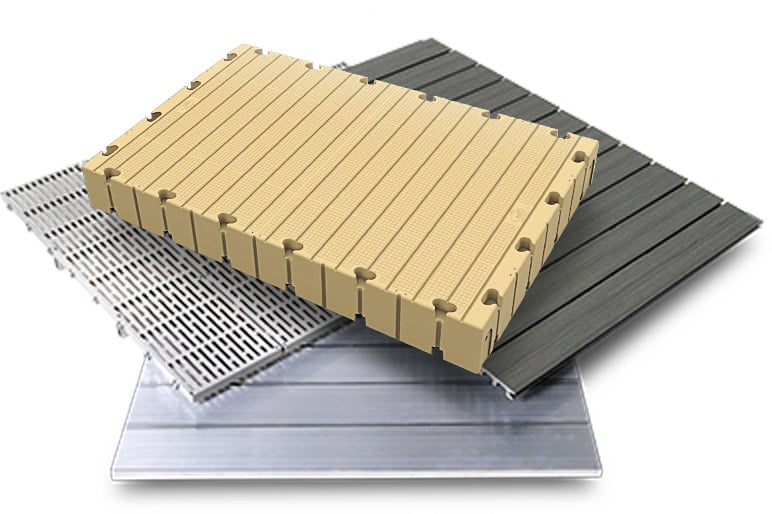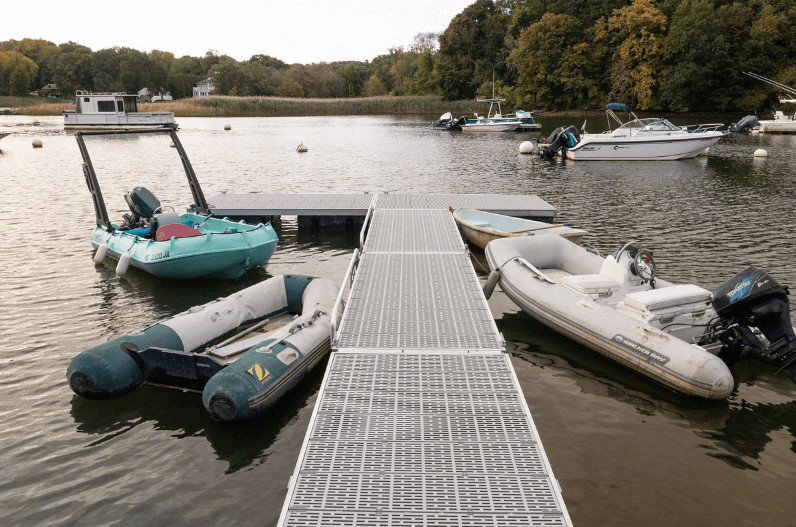Mooring vs Docking Explained
Do you ever find yourself unclear on the exact definition of certain boating terms, especially if you’re a first-time watercraft owner? To clear things up — and to help keep you safe — we want to clarify some of the more commonly used jargon in the industry.
For example — mooring vs. docking. Both terms indicate that you are securing your boat in a permanent location on the water, but you can’t really use them interchangeably. Each term is used for a different procedure, and both require different equipment, which means that you should be aware of the specifics to ensure that you’re properly taking care of your watercraft.
What Does it Mean to Moor a Boat?
What Does it Mean to Dock a Boat?
Docking vs. Docks
Secure Your Watercraft with FWM Docks
FAQs
What Does it Mean to Moor a Boat?
A mooring is a permanent or semi-permanent anchoring system located in the water to which you can secure a boat or watercraft. While this anchor could be a dock, it could also be a buoy, quay, wharf, jetty, or pier.
Mooring is most often used to describe attaching your boat to a mooring buoy in open water. Unlike throwing a traditional anchor overboard, to properly and securely moor a boat, you’ll need three specific pieces of equipment — which are different from those you would need for docking. You’ll need:
- A permanent or semi-permanent mooring anchor
- A heavy and light mooring chain
- A mooring buoy

The type of anchor depends on the location and expected size of the mooring watercraft. The most common types of mooring anchors are:
- Mushroom anchors — This semi-permanent anchor is the popular choice for smaller boats.
- Pyramid anchors — A concentrated weight design used often in marinas.
- Helix anchors — Powerful anchors that are screwed into the ground for the most holding power.
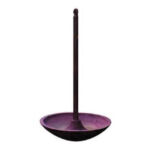
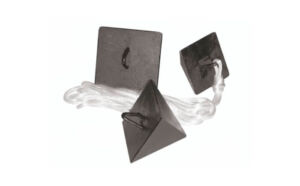
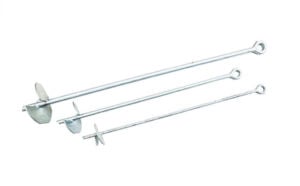
The heavy chain rests on the ground and provides extra weight and support, while the lighter chain provides the buoy some flexibility and maneuverability.
The buoy is what will keep the chain floating and provides you with something to secure your boat. To moor to the buoy, you’ll need something to help you grab hold of it, such as a boat hook or a line. You can either lasso the buoy with your line and pull your boat towards it to further secure it, or use a boat hook to reach out and grab the buoy. Then attach the boat to the buoy with a rope or mooring line.
Moorings can be private or public. Try to avoid hooking up to a mooring if you don’t know who owns it. Not only might it be considered trespassing, but the mooring might not be strong enough to hold your watercraft. If you’re renting a public or commercial mooring, remember that you’re sharing the space with many other boats and watercraft, so you’ll need to do a bit of careful navigating to get into and out of your area.
What Does it Mean to Dock a Boat?
Docking your boat means you’re pulling right up to a dock — or other similar permanent structure — and then securely tying your boat to it with both a bow line (attached to the front of the boat) and a stern line (attached to the back of the boat). Docking usually means that the length of your boat, from bow to stern, will be secured to the dock, giving you a maximum amount of space to embark and disembark from the watercraft, load and unload cargo, and to maintain and clean the vessel.
Docking properly requires that you pull your watercraft alongside a dock as parallel as you can (or fully into a slip), then secure the dock lines to cleats using boating knots. Exactly how you dock your boat depends on a few factors:
Wind and current — If the wind or current is pushing toward the dock, you’ll need to slowly approach in parallel, drifting into position before securing your lines. If the wind or current is pushing you away from the dock, you’ll need to approach at about a 40 degree angle, attaching the bow line first, and then swinging the stern of the boat toward the dock to attach the stern line.

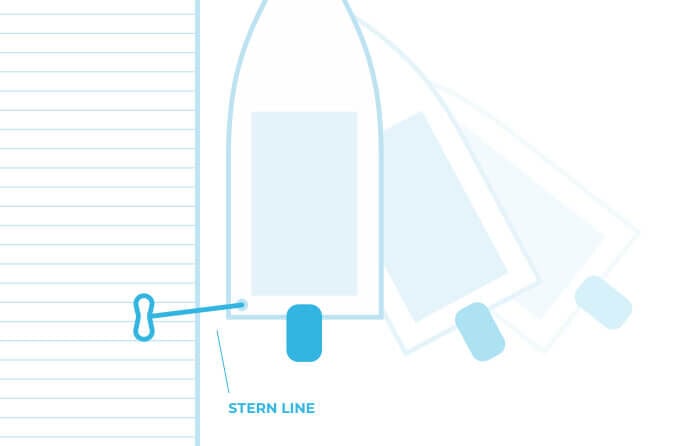
Single engine or multi engine — Most smaller boats have a single, right-hand propeller, which adds an additional sideways force when maneuvering. That force isn’t present with multi-engine boats, so you won’t have to account for the drift and can rely entirely on the shift and throttle controls to maneuver.
To correctly and safely dock your boat you’ll need specific equipment, such as fenders and dock lines:
- Dock lines are ropes, usually made of nylon. Nylon is the preferred material due its strength, elasticity, and resistance to rot and UV rays.
- Fenders are plastic or rubber cushions that act as a buffer between the boat and the dock or other boats, protecting both from bumps and scrapes.
Mooring vs Docking Quick Comparison Chart
| Mooring | Docking | |
| Location | Coastal and offshore waters, lakes | Shorelines, marinas and shipyards |
| Anchor type | A semi-permanent or permanent anchor attached to a buoy | A large, permanent structure alongside which a boat can tie parallel |
| Equipment needed | Mooring anchor, mooring chains, mooring buoy, mooring or dock line | Dock line or mooring line, fenders |
| Pros | Can be done in open water | Provides access to the full length of the boat, easy to embark or disembark |
| General Uses | Open-water fishing, swimming, launching a smaller boat to get ashore, to anchor in case of emergencies, to shelter in severe conditions | To provide shore access, fishing, long or short term storage, recreation, loading/unloading, boarding/disembarking, to repair the vessel |
| Considerations | Be aware of who owns a mooring, and don’t tie up to unfamiliar moorings.Leaving the boat to go ashore requires use of a tender or dinghy. Attaching to a mooring anchor that can’t support the size of the boat can cause severe damage to the boat or mooring. | Finding open space at a public dock can be difficult during busy seasons.Be aware of other water traffic when approaching the dock.Safely docking requires know-how and consideration of the wind, current and your boat’s engine type. |
Docking vs. Docks
A dock is the physical structure or structures where a watercraft is secured to or can be kept to load/unload cargo, to board the vessel, to store it when not in use, to repair it or just to provide access to the water. The word “dock” may also be used to refer to the water adjacent to that structure or structures.
Docking refers to the process of pulling alongside one of those structures and securing both the bow and stern lines to it. Take note that safe docking requires at least two lines; it is possible to moor your boat at a dock by using a single line. This is generally not recommended, as boats should be tied up as securely as possible to avoid damaging the boat, the dock or other watercraft.
As there’s only a single point of attachment to a mooring buoy, you cannot dock at a mooring.
Secure Your Watercraft with FWM Docks
If you want to properly secure your watercraft, choose FWM Docks for all of your docking and mooring needs. If you’re not sure which type of dock solution may be right for you, try our Dock Selector tool. Simply enter your waterfront’s characteristics and we’ll generate our recommendation.
If you have any specific questions, then contact our dock specialists — they’re always happy to help and are on hand to guide you through next steps when purchasing a dock or dock accessories.
FAQs
What’s a berth?
A berth is a distinct space within a dock, pier, quay or similar, permanent marine fixture. To “berth” a boat means securing it in that allotted space for an extended period of time — usually over a full season. Generally boats are docked for a shorter amount of time, from a few hours to several days.
How is anchoring different from docking?
Anchoring your boat refers to dropping a large, heavy object that is attached to your boat into the water, where it settles on or attaches to the seabed. Unlike the more permanent styles of mooring anchors, boat anchors can be either fluke/Danforth style or plow/scoop styles depending on whether you’re anchoring in mud, grass, sand, coral, or rock.
What is rafting up?
Rafting up is essentially mooring one boat to another boat. It can be done when two or more boats need to make a brief stop and there are no available moors. Rafting up can be done in case of emergencies, or if you’re just looking to socialize with another boat on the water.
Download our Top Questions to Ask When Buying a Dock eBook
